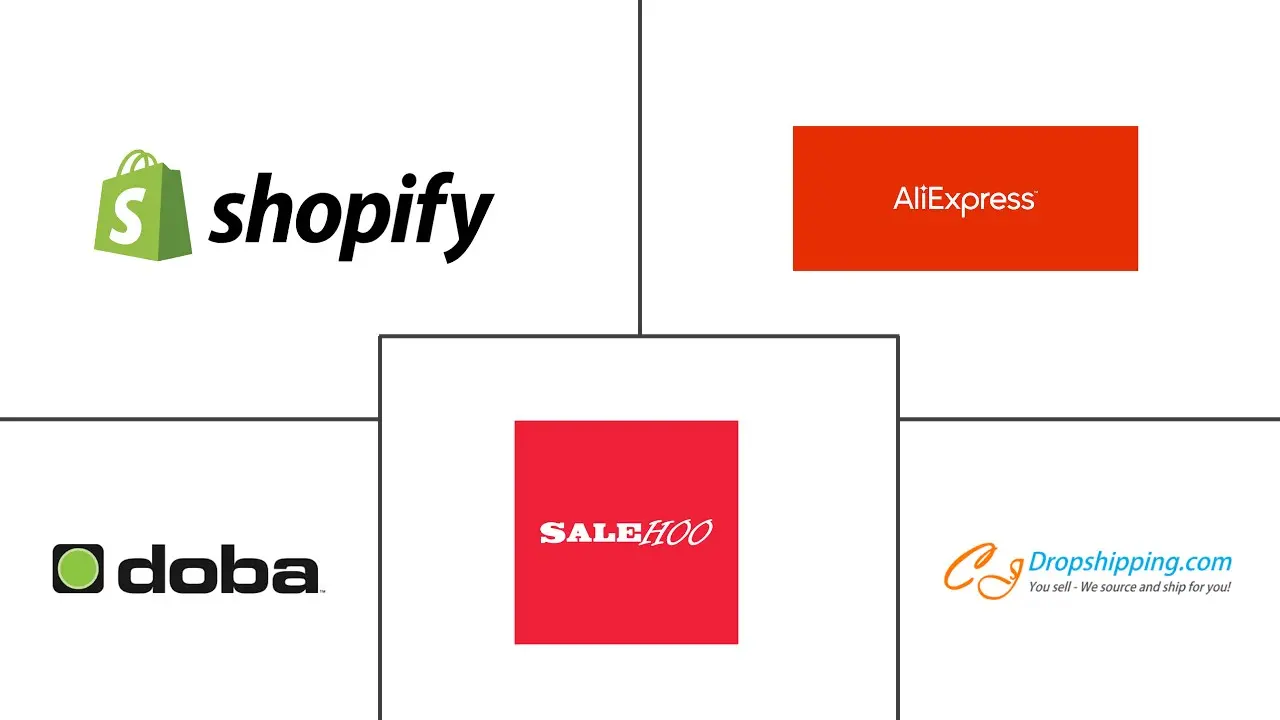Dropshipping Market Size and Share
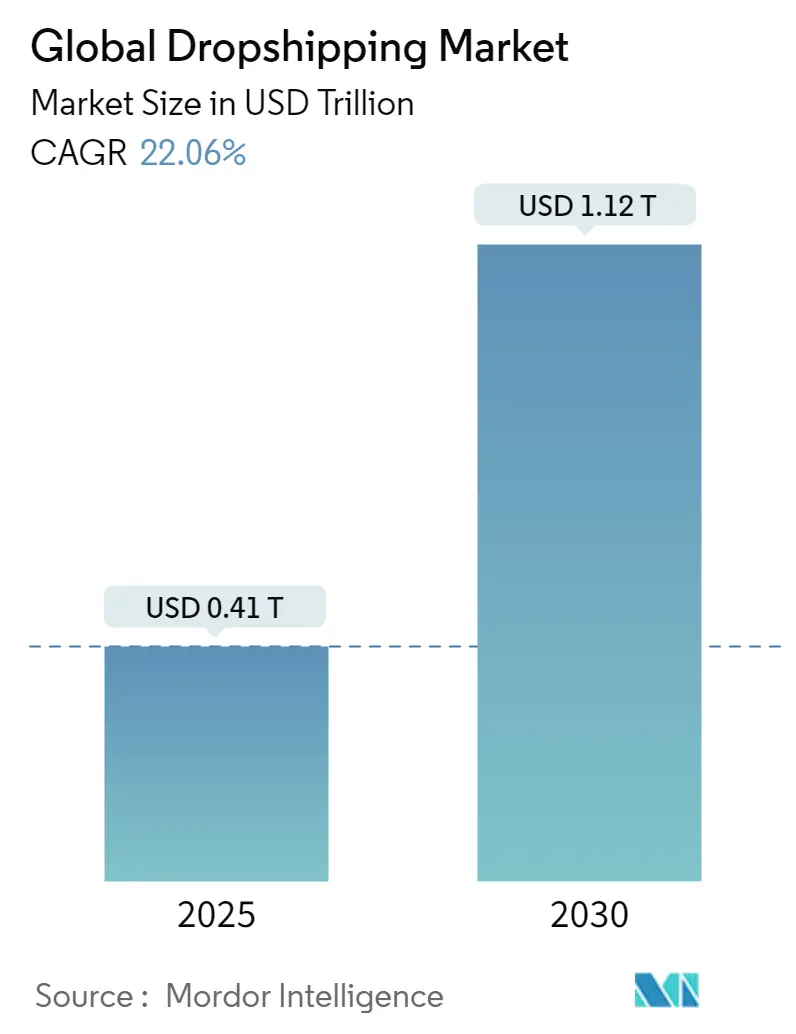
Dropshipping Market Analysis by Mordor Intelligence
The Global Dropshipping Market size is estimated at USD 0.41 trillion in 2025, and is expected to reach USD 1.12 trillion by 2030, at a CAGR of 22.06% during the forecast period (2025-2030).
Strong social-commerce traction, rapid API-based logistics connectivity, and rising e-commerce participation in fast-digitising economies underpin this expansion. Cross-border trade already dominates revenue and is expected to widen its lead as governments, notably in China, continue to invest in bonded zones and overseas warehouses. Fashion’s visual appeal keeps it the highest-earning and fastest-growing category, while social-commerce channels are altering customer acquisition cost curves in favour of micro brands. Competitive intensity remains high because entry barriers stay low and platform consolidation accelerates.
Key Report Takeaways
- By product category, fashion led with 32.8% revenue share of the dropshipping market share in 2024 and is projected to grow at 23.4% CAGR through 2030.
- By destination, cross-border orders captured 61% of the dropshipping market share in 2024 and are forecast to expand at 22.1% CAGR to 2030.
- By sales channel, online marketplaces accounted for 52% of the dropshipping market size in 2024, while social-commerce platforms are advancing at a 27.1% CAGR over 2025-2030.
- By business model, B2C represented 71% of the dropshipping market size in 2024, yet wholesale-oriented suppliers will post the highest 17.4% CAGR to 2030.
Global Dropshipping Market Trends and Insights
Drivers Impact Analysis
| Driver | (≈) % Impact on CAGR Forecast | Geographic Relevance | Impact Timeline |
|---|---|---|---|
| Exploding social-commerce adoption in Gen-Z regions | +4.2% | APAC core, spill-over to North America & EU | Short term (≤ 2 years) |
| Rapid platform API-driven logistics ecosystems | +3.8% | Global, early gains in US, EU & Southeast Asia | Medium term (2-4 years) |
| Mainstream e-commerce penetration in emerging APAC & Africa | +5.1% | APAC & Africa | Long term (≥ 4 years) |
| Creator-economy push for nano-brand monetisation | +3.3% | Global, concentrated in North America, EU & urban APAC | Short term (≤ 2 years) |
| AI-based dynamic pricing & product-test loops | +2.9% | Global | Medium term (2-4 years) |
| SME export incentives in post-COVID trade pacts | +2.8% | APAC core, expanding to Latin America & Africa | Long term (≥ 4 years) |
| Source: Mordor Intelligence | |||
Exploding Social-Commerce Adoption in Gen-Z Regions
Social platforms increasingly embed checkout flows, letting shoppers move from discovery to purchase in a single scroll. Visual feeds and short-form videos shorten the path to impulse buying, particularly for fashion and beauty. Influencers convert audiences into customers at low marginal cost, creating nano-brands that run entirely on outsourced production and fulfilment. Merchants gain instant product-market feedback, but dependence on algorithmic reach exposes them to platform-policy shocks. Tier-1 markets in Southeast Asia set the pace, where more than half of consumers identify social media as their primary discovery channel[1]International Trade Administration, “The Digital Economy of Southeast Asia,” trade.gov.
Rapid Platform API-Driven “Plug-and-Play” Logistics Ecosystems
Unified APIs now connect storefronts, suppliers and multi-node fulfilment networks. Merchants import hundreds of SKUs, sync real-time inventory and generate customs paperwork automatically. China-based hubs ship to US west-coast ports and EU gateways within five days, narrowing the service-level gap with domestic fulfilment. The model grants SMEs enterprise-grade reach without heavy capex. As more carriers open developer portals, switching costs fall further, intensifying price competition yet broadening geographic coverage.
Mainstream E-Commerce Penetration in Emerging APAC & Africa
Smart-phone penetration, lower mobile-data costs and widespread e-wallet adoption bring first-time buyers online across Indonesia, Vietnam, Nigeria and Kenya. Many leapfrog physical retail, engaging directly with overseas merchants. Governments respond with duty-free thresholds and simplified tax regimes to attract platform investment. The Asia-Pacific region is projected to account for half of incremental global consumption this decade, keeping the dropshipping market on a steep growth curve.
Creator-Economy Push for Nano-Brand Monetisation
Content creators blend storytelling with curated product lines, fostering trust-based commerce. Dropshipping offers zero-inventory test runs, supporting quick style pivots and limited editions that sustain audience excitement. AI-driven design tools now translate social-listening insights into SKU concepts, letting creators iterate faster than traditional labels. While the addressable market widens, entry saturation raises the bar on brand authenticity and fulfilment reliability.
Restraints Impact Analysis
| Restraint | (≈) % Impact on CAGR Forecast | Geographic Relevance | Impact Timeline |
|---|---|---|---|
| Intensifying price-led platform competition | -2.7% | Global, acute in North America & EU | Short term (≤ 2 years) |
| Platform content-moderation & regulatory compliance | -3.4% | EU & US, spreading to APAC | Medium term (2-4 years) |
| Payment-fraud charge-back risk amplification | -1.9% | Global | Short term (≤ 2 years) |
| Supplier de-platforming & single-source dependency | -2.1% | Global, China-centric chains at risk | Medium term (2-4 years) |
| Source: Mordor Intelligence | |||
Intensifying Price-Led Platform Competition
Aggressive discount applications from new entrants compress merchant margins. Established marketplaces now experiment with budget storefronts that feature unbranded goods shipped direct from overseas warehouses. A larger share of sponsored-listing real estate is auction-based, pushing customer acquisition costs higher. Merchants respond by differentiating on niche curation and doorstep support rather than race-to-zero pricing.
Platform Content-Moderation and Regulatory Compliance Requirements
Digital-services legislation in the EU and comparable Bills in the US require proof of seller identity, product safety certification and illegal-content takedown protocols. Platforms pass the overhead to vendors through stricter onboarding and higher commission rates. Smaller operators find it costly to keep pace with changing rules, prompting consolidation into managed marketplaces or full-service fulfilment partners.
Segment Analysis
By Product: Fashion Dominance Drives Creator Monetisation
Fashion held a 32.8% share of the dropshipping market in 2024 and is forecast to widen its lead at a 23.4% CAGR to 2030, supported by image-centric discovery and fast-turnover trend cycles. The segment benefits from lightweight parcels, universal size metrics and viral potential for apparel “micro-collections”. Social-video formats enable immediate look-to-buy journeys, boosting unit velocities. Embedded fit-predict algorithms and on-demand print technology curb return rates and unsold inventory.
Emerging cross-border design hubs in Vietnam, Turkey and Bangladesh temper reliance on a single manufacturing base. Mid-tier lifestyle brands outsource capsule lines to test new geographies before committing warehousing spend. Sustainability imperatives steer some merchants to recycled yarns and low-carbon shipping options, raising average order values without diluting convenience.
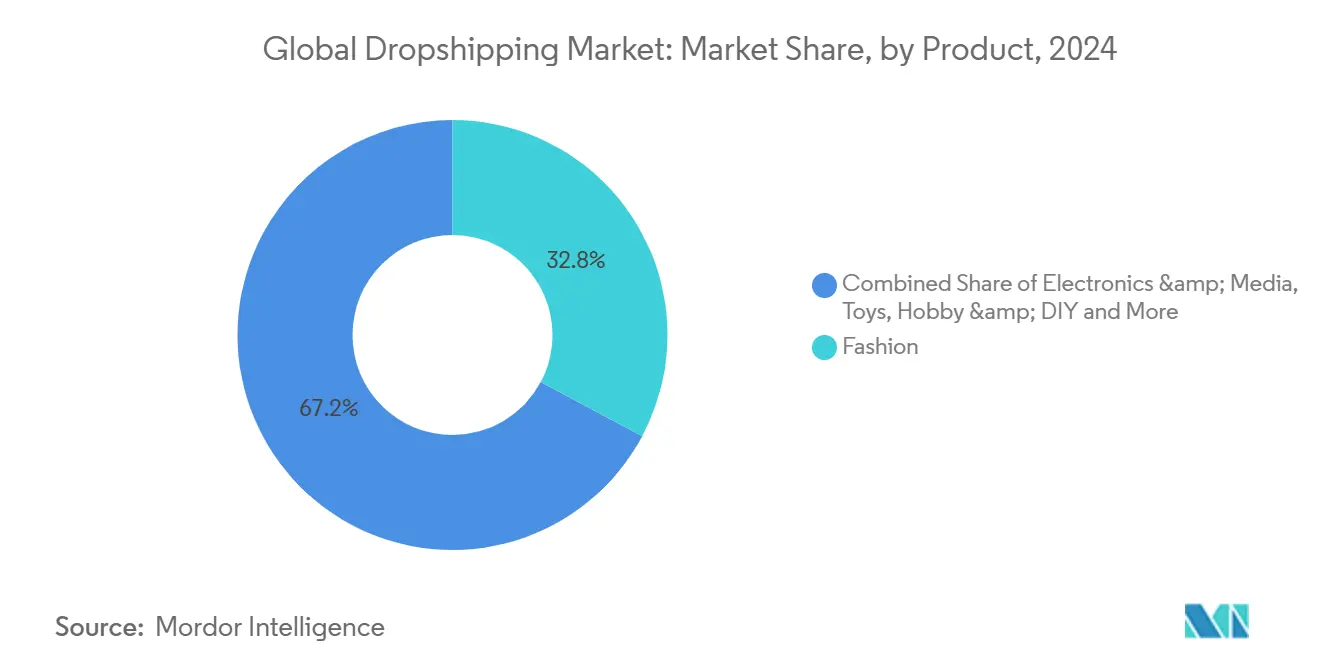
Note: Segment shares of all individual segments available upon report purchase
By Destination: Cross-Border Expansion Accelerates Global Commerce
Cross-border orders contributed 61% of revenue in 2024 and will continue to outpace domestic flows with a 22.1% CAGR. China’s e-commerce export push, covering more than 2,500 overseas warehouses totalling 22 million m², supports five-day delivery to major consumer economies[2]Ministry of Commerce, “Guideline on Accelerating Cross-Border E-commerce Export,” gov.cn. Subsidised freight corridors and bulk-clearing centres cut per-parcel logistics cost, preserving the competitiveness of small-basket orders. The dropshipping market size for cross-border apparel is projected to surpass USD 0.55 trillion by 2030.
Domestic dropshipping retains relevance in bulky or regulated categories where local fulfilment shortens returns cycles and eases compliance checks. Same-day courier networks in the US, UK and Japan present a differentiator for high-trust verticals such as nutraceuticals and premium electronics.
By Sales Channel: Social Commerce Disrupts Traditional Marketplaces
Online marketplaces controlled 52% of sales in 2024, yet social-commerce channels are compounding at 27.1% CAGR and drawing disproportionate attention from new entrants. Algorithm-curated feeds surface products that match entertainment preferences, not keyword intent, driving longer browsing sessions and higher basket adds. Live-stream selling events boost conversion peaks and gather real-time demand signals for inventory planning.
Marketplace incumbents safeguard share by folding influencer shops and video sections into their ecosystems. Some introduce loyalty coins redeemable across third-party stores, narrowing the experiential gap with social apps. However, growing ad inventory inside shopping feeds pushes merchants to balance spend between pay-per-click listings and creator partnerships.
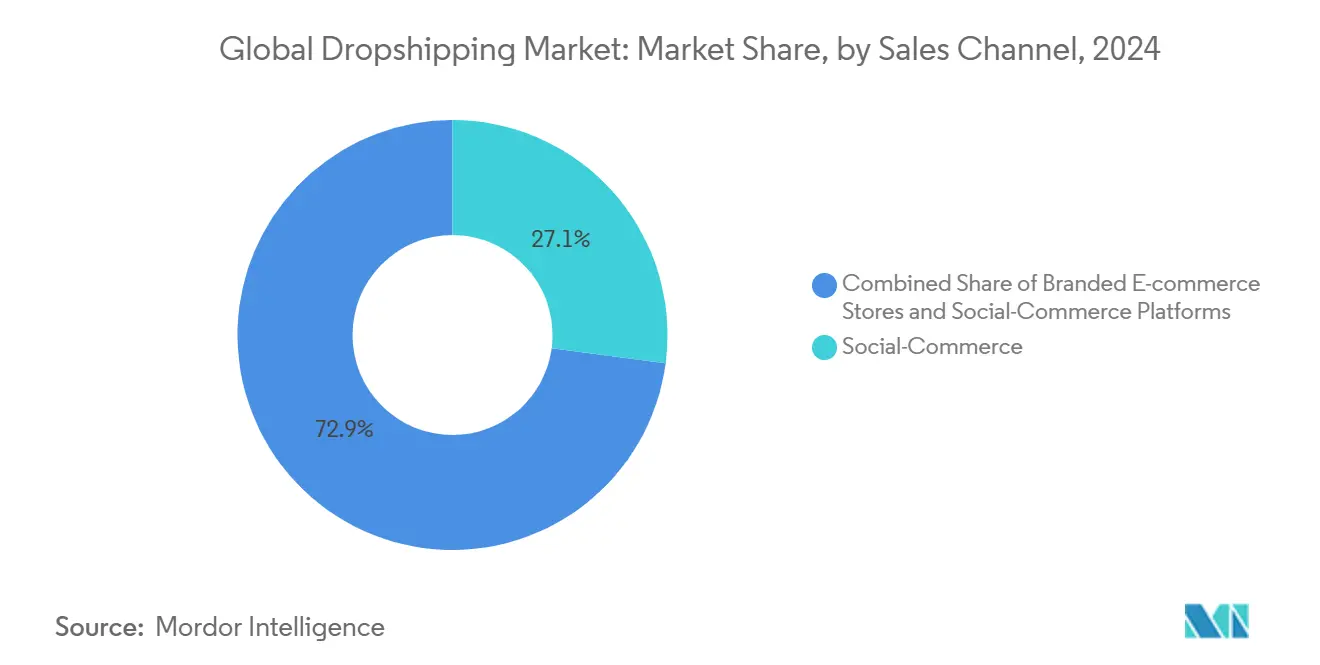
Note: Segment shares of all individual segments available upon report purchase
By Business Model: B2C Leadership Faces Wholesale Disruption
B2C remains the cornerstone, representing 71% of orders in 2024, though its relative slice will recede as wholesale dropshipping accelerates. Retailers use supplier portals to syndicate SKUs without owning stock, enabling breadth expansion while keeping working capital low. The dropshipping market size serving independent store chains is expected to grow at 19% CAGR, fuelled by low-minimum-order fulfilment.
Consumer-to-consumer resale models scale on peer-listing platforms that verify product authenticity and manage escrow payments. Sustainability-minded shoppers spur traction, especially for apparel and consumer electronics. Platform data indicate that one in five Gen-Z buyers prefers pre-owned items, opening a circular revenue loop that intensifies competition for new-goods sellers.
Geography Analysis
North America is the largest regional contributor owing to mature payment rails and high discretionary spending. United States merchants leverage domestic warehouse networks and favourable de-minimis import thresholds to entertain same-week coast-to-coast delivery. Shopify reported USD 8.88 billion in 2024 revenue, highlighting platform stickiness among US SMEs[3]Shopify Inc., “First-Quarter 2025 Financial Results,” shopify.com. Regulatory proposals on data privacy and counterfeit goods heighten compliance costs but also remove non-compliant competitors, indirectly strengthening top-tier sellers.
Asia-Pacific is the fastest-growing theatre. Cross-border exports from mainland China reached CNY 577.6 billion in Q1 2024, a 9.6% year-on-year lift. Southeast Asia’s digital economy is set to exceed USD 330 billion by 2025, with Indonesia accounting for one-quarter of that value. Mobile-first consumers accept longer transit times if pricing remains ultra-competitive, favouring consolidated hub-and-spoke shipping models anchored in Shenzhen and Dongguan.
Europe presents a sophisticated yet heavily regulated landscape. The Digital Services Act enforces risk-management plans and transparent advertising, prompting marketplaces to invest in content filters and traceability dashboards. United Kingdom, Germany and France lead in turnover, while the Nordics exhibit above-average basket values due to purchasing-power parity. Eco-labelling, right-to-repair statutes and extended producer-responsibility schemes reshape sourcing considerations for vendors aiming to protect margins.
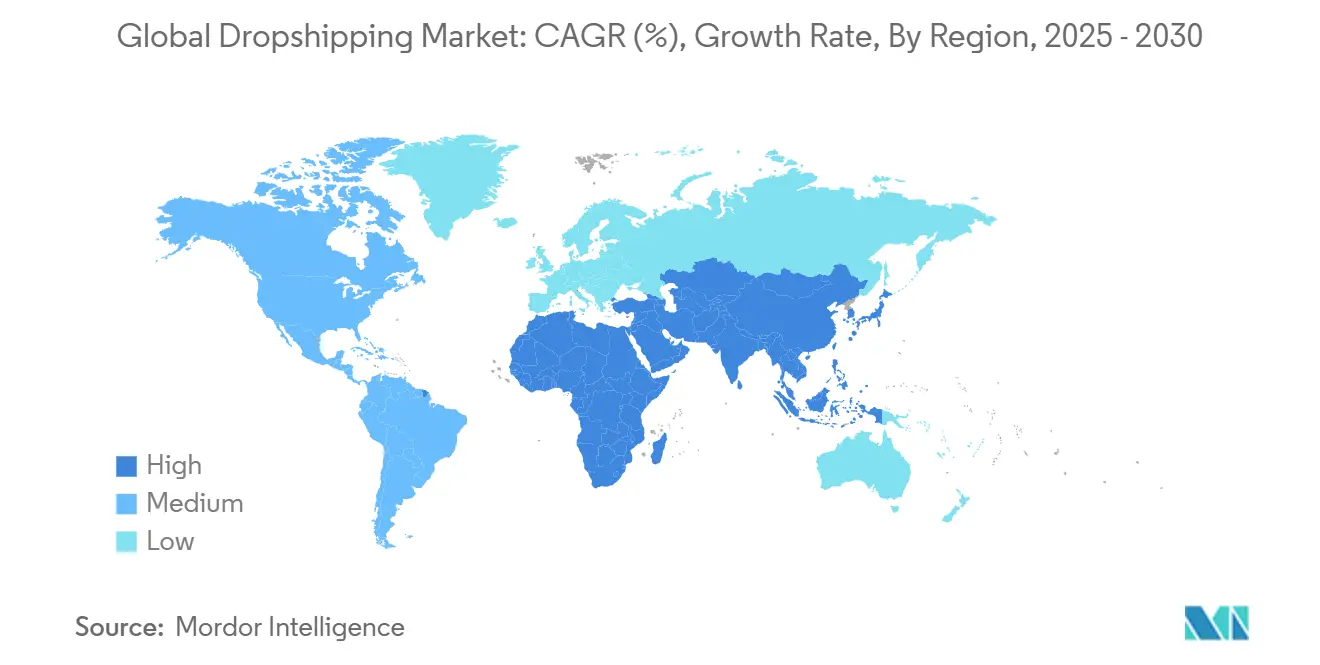
Note: Segments share of all individual segments available upon report purchase
Competitive Landscape
Competition is fragmented, with hundreds of storefront builders, sourcing agents, parcel forwarders and payment gateways vying for merchant loyalty. End-to-end suites gain traction as sellers prefer single dashboards that integrate catalogue synchronisation, tax automation and last-mile tracking. Shopify’s merchant-solutions revenue grew 27% in Q1 2025, reinforcing the value of ecosystem bundling. AliExpress extends its AliExpressLocal programme, letting US-based merchants list domestic inventory through an open API, helping them sidestep certain import documentation.
Technology capabilities are the primary moat. AI recommendation engines, rule-based price bots and predictive-stock modules foster stickiness and swap costs. Logistics partners compete on cross-docking efficiency and customs-pre-clearance algorithms. Niche enablers emerge in compliance—offering Know-Your-Seller verifications and sustainability score-cards—to support EU legislation requirements.
Consolidation manifests through selective acquisitions of app developers and 3PL nodes rather than headline mega-mergers. Platform wallets, insured escrow and instalment payments enhance buyer protection, further distinguishing top-tier providers from smaller plug-ins. Within the dropshipping market, strategic alignment with creator communities and regional live-stream networks appears the next battleground for customer attention.
Dropshipping Industry Leaders
-
Shopify
-
AliExpress
-
SaleHoo
-
Doba
-
CJ Dropshipping
- *Disclaimer: Major Players sorted in no particular order
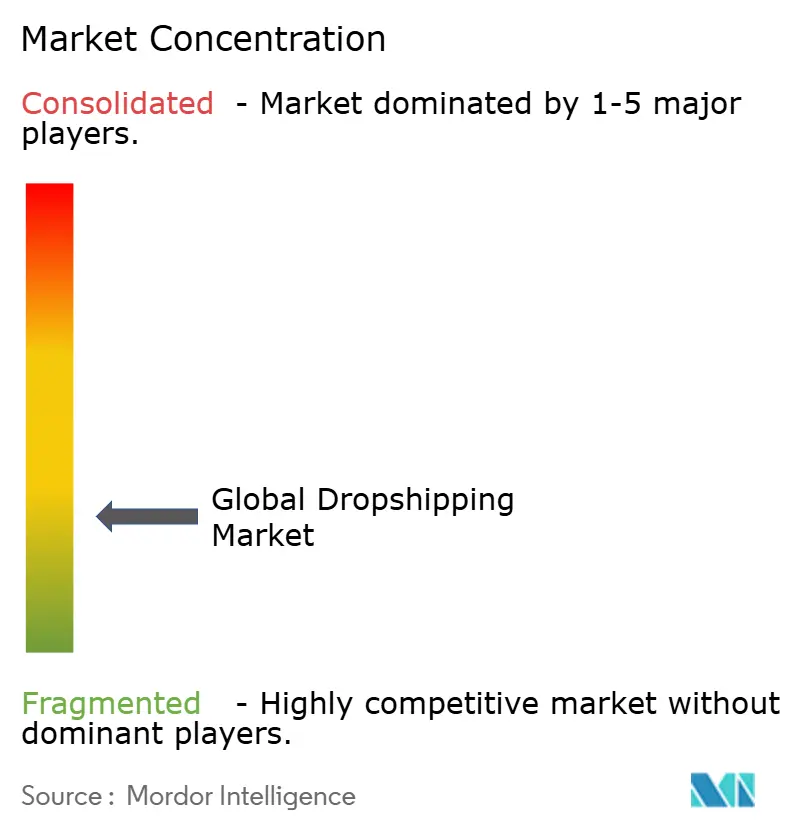
Recent Industry Developments
- March 2025: AliExpress rolled out the AliExpressLocal Marketplace to US sellers, offering an open-API self-serve lane and a managed Direct lane.
- December 2024: Shinsegae Group and Alibaba International formed a USD 4 billion joint venture combining Gmarket and AliExpress Korea under Grand Opus Holdings, enabling 600,000 Gmarket sellers to tap Alibaba’s global reach while strengthening AliExpress’s position in Korea.
- November 2024: Alibaba Group consolidated its domestic and international e-commerce units into a single Alibaba E-commerce Business Group, reversing prior spin-offs to enhance cross-platform synergies.
- September 2024: Shopify, Oracle, and Deloitte Digital launched a three-way collaboration to deliver enterprise commerce solutions through Deloitte’s Next Gen Retail Commerce framework.
Research Methodology Framework and Report Scope
Market Definitions and Key Coverage
Our study defines the global dropshipping market as the value of merchandise ordered online when the retailer owns the customer relationship, but inventory is held and shipped by a third-party supplier; according to Mordor Intelligence, this spans both cross-border and domestic orders placed through online marketplaces, branded web stores, and social-commerce platforms.
Scope exclusion: Print-on-demand, digital downloads, and crowd-funded pre-orders sit outside this analysis.
Segmentation Overview
- By Product
- Fashion
- Electronics & Media
- Toys, Hobby & DIY
- Furniture & Appliances
- Health, Beauty & Personal Care
- Others (Pet, Auto, etc.)
- By Destination
- Domestic
- Cross-border/International
- By Sales Channel
- Online Marketplaces
- Branded E-commerce Stores
- Social-Commerce Platforms
- By Business Model
- B2C
- B2B / Wholesale Dropship
- C2C / Resale
- Geography (Value, USD Bn)
- North America
- United States
- Canada
- Mexico
- South America
- Brazil
- Peru
- Chile
- Argentina
- Rest of South America
- Asia Pacific
- India
- China
- Japan
- Australia
- South Korea
- South East Asia (Singapore, Malaysia, Thailand, Indonesia, Vietnam, and Philippines)
- Rest of Asia-Pacific
- Europe
- United Kingdom
- Germany
- France
- Spain
- Italy
- BENELUX (Belgium, Netherlands, and Luxembourg)
- NORDICS (Denmark, Finland, Iceland, Norway, and Sweden)
- Rest of Europe
- Middle East And Africa
- United Arab of Emirates
- Saudi Arabia
- South Africa
- Nigeria
- Rest of Middle East And Africa
- North America
Detailed Research Methodology and Data Validation
Primary Research
Mordor analysts spoke with marketplace category managers, third-party logistics executives across North America, Europe, and Asia Pacific, plus founders of mid-size dropship stores. Their guidance confirmed supplier onboarding pace, typical margin structures, and real cross-border lead times that rarely surface in public data.
Desk Research
We began by lining up macro data from UN COMTRADE, UPU postal statistics, and World Bank consumer spend tables, then wove in sector insights from sources such as the Ecommerce Foundation and the International Postal Corporation. Company filings, 10-Ks, and select marketplace press releases anchored average selling price checks, while paid feeds from D&B Hoovers and Dow Jones Factiva added firm-level color. The sources named are illustrative; many additional references informed validation.
Market-Sizing & Forecasting
We built a top-down demand pool by linking retail e-commerce spend to the share of orders fulfilled through dropshipping, which is filtered through destination mix and product-level price matrices. Select bottom-up roll-ups, supplier counts in China and sampled order volumes, then fine-tuned totals. Key variables include e-commerce penetration, parcel shipping cost, supplier onboarding rate, marketplace take-rate trends, and social-commerce order share. Forecasts use multivariate regression blended with scenario analysis agreed upon with our primary experts.
Data Validation & Update Cycle
Outputs run through automated variance scans, peer review, and senior sign-off. Reports refresh each year, with interim updates triggered by tariff shifts, large platform policy moves, or comparable material events.
Why Mordor's Dropshipping Baseline Commands Reliability
Published figures often diverge because providers mix fulfillment models, escalate prices differently, or refresh data on uneven cadences, and that is where Mordor Intelligence's disciplined scoping stands out.
Some publishers count gross merchandise value before refunds, while others apply one global average price or ignore duty impacts, which inflates totals.
Benchmark comparison
| Market Size | Anonymized source | Primary gap driver |
|---|---|---|
| USD 0.41 trn | Mordor Intelligence | - |
| USD 0.46 trn | Global Consultancy A | Includes print-on-demand sales and records pre-refund values |
| USD 0.44 trn | Industry Association B | Uses one global ASP and omits duty adjustments |
The comparison shows figures cluster yet still vary; our balanced top-down model, selective bottom-up checks, and year-round validation give decision-makers a transparent, dependable baseline.
Key Questions Answered in the Report
What is the current value of the dropshipping market?
The market is worth USD 0.41 trillion in 2025 and is projected to reach USD 1.12 trillion by 2030.
Which product segment generates the highest revenue?
Fashion leads with a 32.8% share and is expected to grow at 23.4% CAGR through 2030.
How important are cross-border orders for dropshippers?
Cross-border transactions already supply 61% of revenue and will keep growing faster than domestic shipments as overseas warehouse networks expand.
Which sales channel is growing the fastest?
Social-commerce platforms are advancing at a 27.1% CAGR and reshaping how consumers discover products.
What regulations should merchants watch in Europe?
The Digital Services Act enforces stricter seller verification, product safety checks and advertising transparency, raising compliance costs.
Are wholesale dropshipping models gaining traction?
Yes, retailers are increasingly adopting inventory-light wholesale arrangements to widen assortments without tying up working capital, outpacing B2C growth rates.
Page last updated on:
